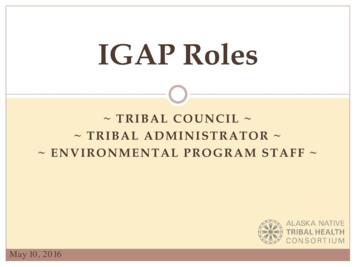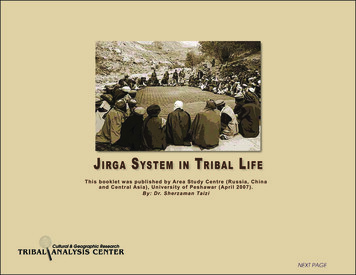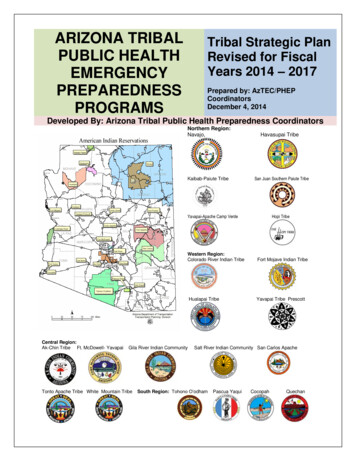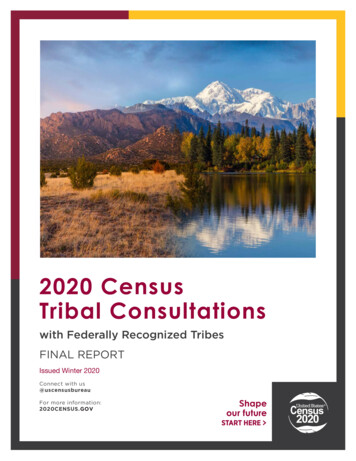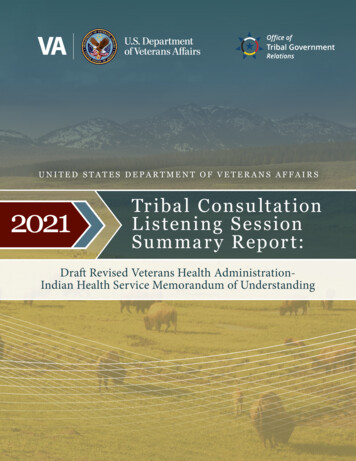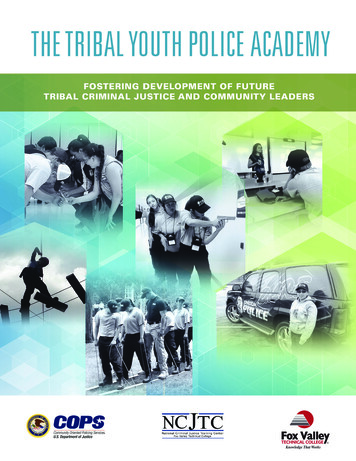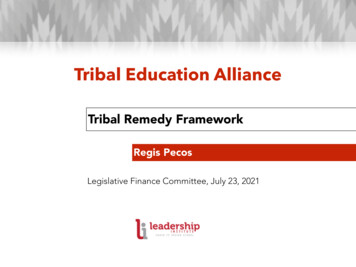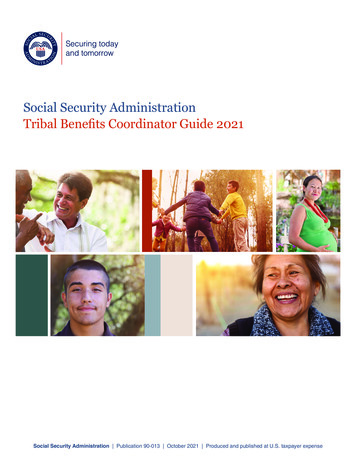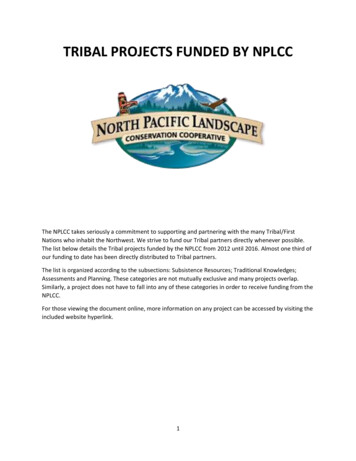
Transcription
TRIBAL PROJECTS FUNDED BY NPLCCThe NPLCC takes seriously a commitment to supporting and partnering with the many Tribal/FirstNations who inhabit the Northwest. We strive to fund our Tribal partners directly whenever possible.The list below details the Tribal projects funded by the NPLCC from 2012 until 2016. Almost one third ofour funding to date has been directly distributed to Tribal partners.The list is organized according to the subsections: Subsistence Resources; Traditional Knowledges;Assessments and Planning. These categories are not mutually exclusive and many projects overlap.Similarly, a project does not have to fall into any of these categories in order to receive funding from theNPLCC.For those viewing the document online, more information on any project can be accessed by visiting theincluded website hyperlink.1
SUBSISTENCE RESOURCESStudying Effects of Climate Change on the Traditional Gathering CalendarOrganized Village of Kasaan, Alaska, 2012The goal of this project was to interview multiple generations of tribal gatherers from the Craig,Hydaburg, Kasaan and Klawock Tribal communities on Prince of Wales Island to determine whichresources are gathered and the weather conditions they are most commonly found in. Thisinformation, which included timings of gathering practices, factors influencing the ability togather, and impacts of commercialization, comprised baseline data for a traditional gatheringcalendar. The inclusion of multiple generations allowed researchers to analyze how thesepractices have changed over time and assess how climate change might impact the seasonalityof gathering resources.Website (link)Assessing Impacts of Climate Change on Pacific Lamprey and Pacific EulachonColumbia River Inter-Tribal Fish Commission, Oregon/Washington, 2013Pacific Lamprey and Pacific Eulachon, important firstfoods for Native American peoples of the PacificNorthwest, are facing unprecedented threats fromhabitat, temperature, and migration changes. This projectevaluated the potential for Pacific Lamprey and PacificEulachon to survive under current climate changepredictions. The project considered how changes toocean conditions and freshwater habitat would impactthe life cycles and survivability of these fish populations. Through communicating with manystate, federal, university, and tribal organizations, the results are intended to inform a variety ofmanagement techniques throughout the Pacific Northwest.Website (link)2
Mapping Relationships between Increasing Moths and Decreasing BerriesChugachmiut Tribal Consortium, Alaska, 2013Due to increasingly warmer winters in Alaska, Geometrid moth populations are growing largerand surviving longer than ever before. The Geometrid moth outbreaks are decimatingsalmonberry and blueberry plants, causing berry failures to be worse than at any time in eldermemories or written history. This project developed a risk model to predict where subsistenceberry plants will be most resistant to attacks from the Geometrid moth. The information couldthen be used to predict where treatments would be most successful in order to sustain aplentiful subsistence berry supply and fuel wood for wood energy projects.Website (link)Climate Change and Fish-Bearing Streams in Western WashingtonPoint No Point Treaty Council, Washington, 2016The rivers and tributaries of Northwest Washington State are home to several endangeredspecies, including Summer Chum, Puget Sound Chinook, Steelhead, and Bull Trout. These speciesexist in traditional fishing areas and are essential to Tribal subsistence, cultural, and economicpractices. This study will therefore provide streamflow predictions through the end of the 21stcentury under a range of climate change scenarios for five major streams and tributaries in theOlympic Peninsula. Such data will help to address vulnerability assessments and threats tohabitat, while providing managers and governments with the first streamflow projections in theregion.Wesbite (link)3
TRADITIONAL KNOWLEDGESSea-level Rise and Coastal Cultural Resources at Tolowa Dunes State Park, CACalifornia Department of Parks and Recreation, California, 2012This project aimed to interview Tolowa elders from Elk Valley and Smith River Rancheria todocument relationships between tsunamis and traditional smelt fishing camps. Due to coastalerosion from rising sea levels, archeological deposits are becoming exposed at Tolowa DunesState Park, making cultural remains vulnerable to looting, animal disturbance, and weathererosion. Using the information generated from interviews with elders and GIS calculations, thisproject mapped the next century of inundation and overlaid this data with known archaeologicaland natural resources of importance to Tolowa people.Website (link)Establishing Best Practices for Gathering and Sharing Traditional KnowledgeCentral Council of Tlingit and Haida Indian Tribes of Alaska, Alaska, 2012These funds provided support for the traditional gathering calendar developed by the OrganizedVillage of Kasaan. The Central Council worked with the Southeast Alaska Tribes Climate ChangeCommittee to create work plans for all Southeast Alaska Tribes to follow when initiatingresearch into traditional ecological knowledge (TEK). The Central Council and SE Alaska TribesClimate Change Committee met to support, review, and guide the process of the OrganizedVillage of Kasaan’s NPLCC grant.Website (link)4
Utilizing Yurok Traditional Knowledge to Inform Climate Change PrioritiesYurok Tribe, California, 2012This project collected knowledge from tribal elders on ecosystem function, communitystructure, species behavior, habitat use, traditional Yurok management approaches, and howeach of these have changed over time. The information was then used to identify areas toprioritize for tribal research. The project also served as a model for other tribal and non-tribalentities who wish to utilize culturally-sensitive research methods, as, for example, traditionalknowledge was used to identify climate change priorities without compromising the privacy ofculturally-sensitive information.Website (link)Tribal Recommendations on the Use of Traditional KnowledgeTulalip Tribes, Washington, 2012Generating collaboration among 21 Tribes of the Northwest Indian Fisheries Commission, thisproject initiated the first large-scale inter-Tribal government discussions regarding therelationship between scientific research and traditional knowledge in NPLCC activities. Fundingprovided assistance for three regional meetings and resulted in a white paper outliningguidelines for respecting, understanding, and engaging with traditional knowledge in scientificresearch.Website (link)Tribal Knowledge and Self-Determination in the Face of Climate ChangeKaruk Tribe, California, 2012The homelands of the Karuk Tribe of the Klamath Basin, Northern California are largely ownedby federal agencies such as the U.S. Forest Service, creating considerable challenges to theimplementation of tribal restoration techniques and ability to exercise tribal sovereignty. Theproject identifies institutional and cultural barriers to the integration of TEK and Karukmanagement and subsequent proactive tools to overcome these barriers. Particularly in thecontext of the increasingly dangerous wildfires that spread rapidly throughout Karuk territorymost summers, it is important that these barriers to traditional management are activelyidentified and improved.Website (link)5
Klamath Basin Traditional Ecological Knowledge and Climate Science InternshipQuartz Valley Indian Reservation, California, 2013This internship provided 5 tribal collegestudents the opportunity to conductpersonal research projects under thementorship of tribal leaders and federalscientists during the summer of 2014.Students from the Tribal Nations of theKlamath Basin were able to meet withand interview tribal elders andpractitioners, learn federal forestry andfisheries monitoring techniques, andparticipate in conservation fieldwork, while gaining experience in environmental analysis,management, and policy. Their final projects spanned an array of topics including firemanagement, traditional foods, gathering practices, community health, and aquatic restoration.Website (link)Tribal Perspectives on Developing Resilience to Climate ChangeOregon Climate Change Research Institute, Oregon/Washington, 2016In collaboration with the Quinault Indian Nation of Washington and the Confederated Tribes ofSiletz Indians of Oregon, researchers will co-develop a guidebook for tribal climate changeadaptation. Prioritizing Tribal values and the importance of knowledge held within Tribalcommunities, the guidebook will serve as a foundational document for many Tribal Nations andfederal agencies.Website (link)Creating an Inventory of British Columbia First Nations Engagement with Climate ChangeBritish Columbia Ministry of Forests, Lands and Natural Resources (FLNRO), B.C., Canada, 2016The British Columbia Ministry of FLNRO is creating an inventory of all climate change research,adaptation plans, vulnerability assessments, and mitigation projects that have been initiated byFirst Nation communities in British Columbia. The database will promote awareness of theenvironmental changes First Nations are witnessing while bridging an important information gapbetween natural resource managers and First Nations.Website (link)6
ASSESSMENTS AND PLANNINGHeiltsuk Participation in Designating Forest ReservesHeiltsuk Integrated Resource Management Department, British Columbia, Canada, 2012Heiltsuk members collected spatial and photographic data, which was integrated with GISmapping, to identify areas to set aside from logging and development over short and longtimeframes. The project succeeded in increasing community awareness of the distribution ofcultural features and resource values throughout Heiltsuk territory and providing baseline datafrom which to monitor impacts of climate change over time.Website (link)Identifying Climate Vulnerabilities and Prioritizing Adaptation StrategiesChilkoot Indian Association, Alaska, 2013This project strives to complete a vulnerability assessment and adaptation plan for Eulachonthat spawn in the Chilkoot and Chilkat rivers. Community members are involved in the collectionof data on the spawning populations and the organizing of stakeholder meetings to analyzeprojections, apply community knowledge, and rank climate vulnerabilities. The project will resultin tribally identified and prioritized adaptation strategies for Eulachon populations that aregrounded in local monitoring efforts and are directly applicable to the citizen-basedmanagement of the fishery.Website (link)Nooksack River Climate Change Vulnerability Assessment, River Restoration Planning, and AdaptationPlanNooksack Indian Tribe, Washington, 2014With increasingly warming temperatures in the Pacific Northwest, studies report that glaciersare currently smaller than at any time in the last 4000 years. For the Nooksack Indian Tribe who7
depend on resources from the Nooksack River, changes in snow melt are altering thetemperature, sediment, and flow of the river. The purpose of this project is to evaluate theeffect of climate change on glacier stability, and in turn, how this will influence Nooksack Riverflow regimes and fish. Data from such projections are used to conduct a vulnerabilityassessment, support salmon habitat restoration, and prepare an adaptation plan.Website (link)Climate Change and Human Health in the Salish Sea: Developing Indigenous Health IndicatorsSwinomish Indian Tribal Community, Washington, 2012Through interviews with community members and climatemodeling, participants tailored a series of IndigenousHealth Indicators to evaluate the health of Indigenouscommunities and their traditional resources. Theindicators include: community connection, naturalresources security, cultural use, education, selfdetermination, and calm mind. Researchers evaluatedhow Swinomish communities were experiencing climaticchanges through the lens of the Indigenous HealthIndicators, and using widespread community input, rankedlevels of concern and projected risks.Website (link)Tribal Climate Change Partnership: Climate Science Connections DatabasePacific Northwest Tribal Climate Change Network, Entire NPLCC Region, 2015The Pacific Northwest Tribal Climate Change Project works to build an understanding of theimpacts that climate change may have on American Indian and Alaska Native tribal cultures andsovereignty. This grant supports the Network in building science connections between Tribes,developing an online database, and communicating among and beyond Tribes the needs,lessons, and opportunities that Native Nations have in planning for the effects of climatechange.Website (link)8
This internship provided 5 tribal college students the opportunity to conduct personal research projects under the mentorship of tribal leaders and federal scientists during the summer of 2014. Students from the Tribal Nations of the Klamath Basin were able to meet with and interview tribal elders and practitioners, learn federal forestry and
